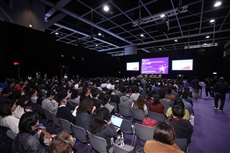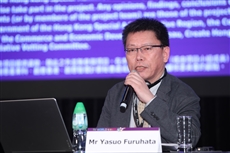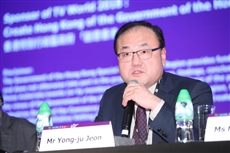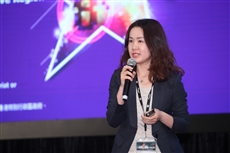FILMART Seminar:How can traditional TV and new media coexist
21 March 2018 – During a panel discussion at the HKTDC Hong Kong International Film and Television Market (FILMART), speakers from the Chinese Mainland, Japan, Korea and Hong Kong analysed the challenges facing traditional TV, the changing viewer habits both online and offline, and what TV companies have to do to adapt to the digital world. FILMART is held at the Hong Kong Convention and Exhibition Centre until tomorrow.
Changes in Japanese viewing habits
A series of thematic seminars led by global industry leaders are held during FILMART, including the 20 March session entitled “Television and new media: Competitors? Or complement each other?” Yasuo Furuhata, Deputy Editor of Global Information Desk, Kyodo News, provided Japanese statistics to explain the major changes in Japanese viewing habits. Mobile ownership in Japan has increased 400 per cent in the past five years and young people spend 150 minutes a day on small-screen mobiles. He pointed out that it was not just TV viewing habits that were undergoing momentous changes. Computer viewing has declined as well. Today, 10 to 20 year olds spend 150 minutes a day, on average, on small screen mobiles. And like everywhere else, social media usage has skyrocketed, rising from 24.4% in 2010 to 71.2% in 2017.
Meanwhile, traditional media viewership has continued to fall, from 100% in 2008 to 65.6% in 2016. Yet costs for traditional media companies continue to rise. Along with the aging population, fewer people are subscribing to newspapers, resulting in a 50% reduction in advertising in the past 15 years.
Competing in a changing Korean market
Jeon Yong Ju, President & CEO of D’Live from Korea, focused on some of the reasons for the major shift from TV to smartphones and what content producers have to do to compete with new media companies. Last year in Korea, one-third of smartphone owners used an alt TV app, but Mr Jeong predicted that in the long run, most Koreans would use smartphones for TV viewing. His company has already set up 150,000 alt-TV boxes in Korea, so everything on TV can now be viewed on smartphones. His companies are actively incorporating these new TV platforms, which can also support AR/VR and other new services. He cautioned that there is presently a lack of content for AV/VR, but that AR has great potential to appeal to less tech-savvy older viewers.
Mr Jeon said his group has a strong alliance with on-demand streaming media providers, such as Sony and Netflix. He said all TV companies would have to cross over to new media and predicted that more companies would seek global alliances to compete, adding that smart devices opened the door to new services for these companies.
Changing online viewing habits in the Mainland
Michelle Mou, CEO of New Studios Picture, explained that shifting from TV to internet was not just a matter of putting TV content online. The operation mode is different, viewer habits and behaviour are different, viewer demographics have changed, distribution has changed, and data gathering technology has become much more advanced, allowing more precise understanding of viewer preferences than ever before.
Although only six years old, New Studios produces 10,000 short films a year and about 100 long films, the latter mainly for TV. Subscribers to the company’s service have increased six-fold in three years, from 10 million in 2015 to 60 million now. But with about 800 million people now living in cities in the Mainland, there are potentially about 500 million subscribers. Ms Mu said her company would provide the content subscribers want.
The most fascinating part of Ms Mu’s talk was her description of how online viewing habits have changed and how New Studios is adapting content, length and screen appearance to make its product more appealing on the small screen and to satisfy fast-changing viewer preferences.
First, viewer habits. The average age of viewers is younger and they have more choices than ever before. Some 40% of films on mobile are viewed for less than 20 minutes, and 20% are viewed for less than 10 minutes. Therefore, short content is much more popular and a key trend among Mainland viewers is to use the fast-forward function to take in as much of the content as possible in the shortest time. She explained an interesting contrast between TV and online peak viewer periods. For TV, 8pm is the golden period, though for the younger segment it is 9pm. But online viewing has two other golden periods: travelling to and from work in the morning and evening, and lunchtime. The shortened attention span is so crucial that some Korean dramas have been shortened to eight minutes per episode.
Second, adapting to the small screen. The visuals must be adjusted to show as much information as possible on the small screen. As far as ads are concerned, attracting attention is key and they must include as much information as possible in the small screen. If an ad is full screen, their data shows that it is nine times more effective than if it is partial screen.
Third, viewer feedback. Data gathering technology allows New Studios to determine precise viewer behaviour, including time spent viewing, fast-forwarding, time and content preferences, and so forth. Online viewing also allows viewer feedback in the comment section, making it a truly interactive experience and providing valuable data for content providers. In some videos, viewers can actually vote to decide future action in the video.
Restrictions of Traditional TV
Ng Yu, Chief Executive Officer of Asia Television Digital Media Limited, pointed out that ATV always had a wide audience in the Pearl River Delta area. He said it was important to preserve this tradition, but that it was outdated. He estimated that Hong Kong lagged behind the Mainland by about 10 years, and that Hong Kong has only millions of potential viewers, while the Mainland has hundreds of millions.
Mr Ng pointed out that HK TV faced a number of restrictions. One involved licensing. Eliminating this restriction would allow producers to save money and produce more programmes.
Another problem with traditional TV is the restriction in time and space. With TV you have to sit at home, while on mobile devices you can watch content anytime, anywhere. He said even 70-somethings are downloading the ATV app. This flexibility allows Hong Kong content providers the opportunity to go global.
Internet content providers have more options for generating income: ads, subscriptions, e-commerce, etc., while TV generates income only by selling ads and programmes.
Another problem with TV is that it is one way, while internet viewing is interactive. Viewers can interact on chat apps, play games, win prizes or sent flowers, for example. And there will be more interaction in the future.
Internet viewing offers much more choice. In the past we had to watch what TV gave us, but now even older people won’t do that anymore. Users have the say now. He said traditional TV still has some advantages, but they are fading fast. He concluded that rich content and skilled and creative manpower were the keys to success.
But he also commented that money was an important issue, with Netflix investing $8bn in drama series, and Mainland producers spending RMB2million per episode for drama series. With its small viewing population, Hong Kong cannot compete.
What can traditional TV do to compete with the digital market?
Michelle Mou argued that talent was more important than money. She said innovative and creative people and good content were the keys. Next, you have to look at consumption patterns, especially the popularity of mobile devices.
Jeon Yong Ju said that traditional TV had to adapt to the digital world with more tailored content for the younger generation. He pointed out that in digital areas, young people throughout Asia seemed to enjoy the same content and that this would help remove barriers between countries.
Yasuo Furuhata said that although Korea had surpassed Japan in TV film and music, a lot of Japanese content was still popular in Asian countries, especially cartoons, and that Japanese companies needed to explore more markets, focusing on the digital market to take advantage of its strengths. He said that although people were watching less TV in Japan, it was still stable compared to TV in other places.
Ng Yu said Hong Kong TV stations must nurture talent, not just focus on trying to produce good content. TVB is having trouble finding enough talent and now has to recruit talent from the Mainland. He said at present Hong Kong does not have enough talent to compete in the digital world. He said that Hong Kong does not have the government support in this area that other places have and that this support is very important, but in the end, we have to help ourselves, not depend on the government. He said we must throw away the traditional TV mode and take a macro view. TV is local culture and local TV stations should stick with Cantonese and cater for local culture. But they should also target the Greater Bay Area and make a special channel for Southeast Asia. To developing the global market, local TV companies had to move quickly to online viewing.
FILMART website: http://m.hktdc.com/fair/hkfilmart-en
Entertainment Expo website: http://www.eexpohk.com
FILMART schedule
|
19-21 March (Monday-Wednesday) |
9:30am-6pm |
|
22 March (Thursday) |
9:30am-5pm |
|
|
Thematic seminar, “Television and new media: Competitors? Or complement each other?” was held on 20 March.
|
|
|
Yasuo Furuhata, Deputy Editor of Global Information Office, Kyodo News Service |
|
|
Jeon Yong Ju, President & CEO of D’Live |
|
|
Michelle Mou, CEO of New Studios Picture |
|
|
Ng Yu, Chief Executive Officer of Asia Television Digital Media Limited |
Media enquiries
Please contact the HKTDC's Communications & Public Affairs Department:
Banbi Chen Tel: (852) 2584 4525 Email: banbi.yc.chen@hktdc.org
Sunny Ng Tel: (852) 2584 4357 Email: sunny.sl.ng@hktdc.org
Media registration: Media representatives wishing to cover the event may register on-site with their business cards and/or media identification.
To view press releases in Chinese, please visit http://mediaroom.hktdc.com/tc
About the HKTDC
Established in 1966, the Hong Kong Trade Development Council (HKTDC) is a statutory body dedicated to creating opportunities for Hong Kong’s businesses. With more than 40 offices globally, including 13 on the Chinese mainland, the HKTDC promotes Hong Kong as a platform for doing business with China, Asia and the world. With 50 years of experience, the HKTDC organises international exhibitions, conferences and business missions to provide companies, particularly SMEs, with business opportunities on the mainland and in international markets, while providing information via trade publications, research reports and digital channels including the media room. For more information, please visit: www.hktdc.com/aboutus.






